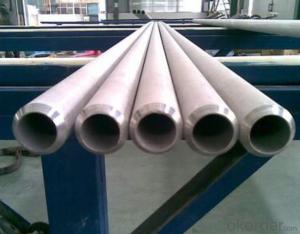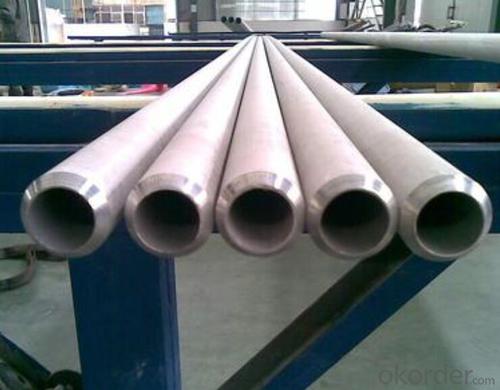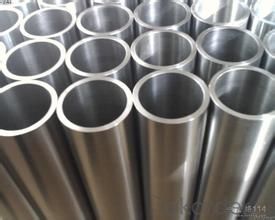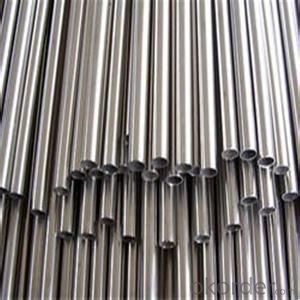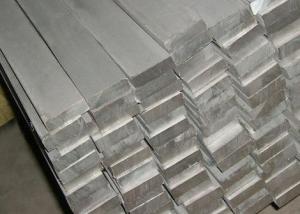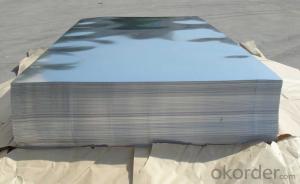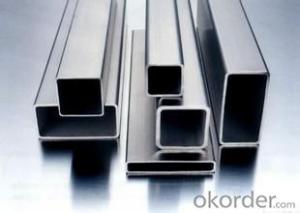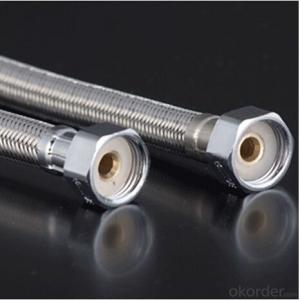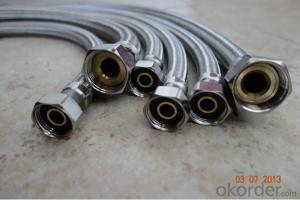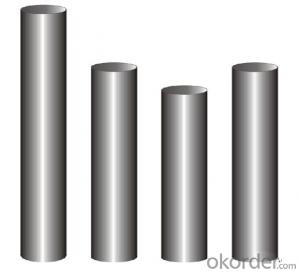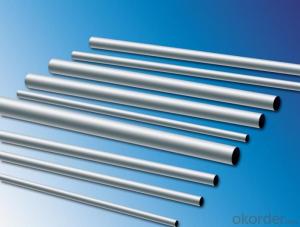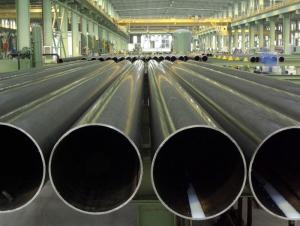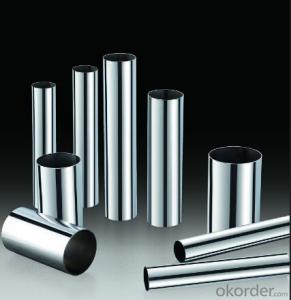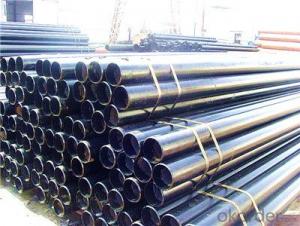Stainless Seamless Steel Tube With High Quality
- Loading Port:
- China main port
- Payment Terms:
- TT or LC
- Min Order Qty:
- 100 m.t.
- Supply Capability:
- 10000 m.t./month
OKorder Service Pledge
OKorder Financial Service
You Might Also Like
1、Structure of Seamless Pipe ASTM A106/53:
Seamless pipe is formed by drawing a solid billet over a piercing rod to create the hollow shell. As the manufacturing process does not include any welding, seamless pipes are perceived to be stronger and more reliable. Historically seamless pipe was regarded as withstanding pressure better than other types, and was often more easily available than welded pipe.
2、Main Features of the Seamless Pipe ASTM A106/53:
• High manufacturing accuracy
• Good visual effect
• Reasonable price
3、Seamless Pipe ASTM A106/53 Specification:
Standard | GB, DIN, ASTM ASTM A106-2006, ASTM A53-2007 |
Grade | 10#-45#, 16Mn 10#, 20#, 45#, 16Mn |
Thickness | 8 - 33 mm |
Section Shape | Round |
Outer Diameter | 133 - 219 mm |
Place of Origin | Shandong, China (Mainland) |
Secondary Or Not | Non-secondary |
Application | Hydraulic Pipe |
Technique | Cold Drawn |
Certification | API |
Surface Treatment | factory state or painted black |
Special Pipe | API Pipe |
Alloy Or Not | Non-alloy |
Length | 5-12M |
Outer Diameter | 21.3-610mm |
Grade | 20#, 45#, Q345, API J55, API K55, API L80, API N80, API P110, A53B |
Standard | ASME, ASTM |
1) Material:20#(ASTM A 106/A53 GRB.API5LGRB,GB),45#,16Mn,10#.
2) Specification range:OD:21.3-610mm,WT:6-70mm,length:6-12m or according to the requirement of clients.
3) Excutive standards:GB,ASME API5L.ASTM A 106/A53,Despite of the above standards,we can also supply seamless steel pipe with standard of DIN,JIS,and so on,and also develop new products according to the requirements of our clients!
4、Packaging & Delivery
Packaging Details: | seaworthy package,bundles wrapped with strong steel strip |
Delivery Detail: | 15-30days after received 30%TT |
5、FAQ of Seamless Pipe ASTM A106/53:
①How is the quality of your products?
Our products are manufactured strictly according to national and internaional standard, and we take a test on every pipe before delivered out. If you want see our quality certifications and all kinds of testing report, please just ask us for it.
Guaranteed: If products’ quality don’t accord to discription as we give or the promise before you place order, we promise 100% refund.
②How about price?
Yes, we are factory and be able to give you lowest price below market one, and we have a policy that “ for saving time and absolutely honest business attitude, we quote as lowest as possible for any customer, and discount can be given according to quantity”,if you like bargain and factory price is not low enough as you think, just don’t waste your time.Please trust the quotation we would give you, it is professional one.
6、Seamless Pipe ASTM A106/53 Images:
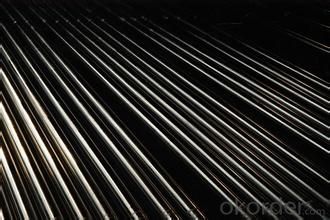
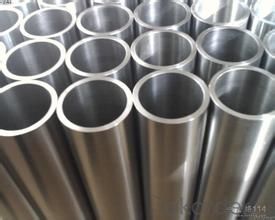
- Q: Can stainless steel pipes be used for oil and gas transportation?
- Yes, stainless steel pipes can be used for oil and gas transportation. Stainless steel is a popular material choice for pipes in the oil and gas industry due to its high corrosion resistance and durability. These pipes are able to withstand harsh conditions, such as high pressure, extreme temperatures, and corrosive environments, making them suitable for transporting oil and gas. Additionally, stainless steel pipes are known for their ability to maintain the purity of the transported fluids, as they do not react with or contaminate the substances being transported. Overall, stainless steel pipes are a reliable and efficient option for oil and gas transportation.
- Q: What is the difference between annealed and tempered stainless steel pipes?
- Annealed and tempered stainless steel pipes are both heat-treated to enhance their properties, but they differ in terms of their mechanical characteristics and applications. Annealed stainless steel pipes are soft and ductile due to the annealing process, which involves heating the material to a high temperature and then slowly cooling it. This process relieves internal stresses and increases the steel's flexibility, making it easier to bend and form. Annealed pipes have lower hardness and strength but are more resistant to corrosion. On the other hand, tempered stainless steel pipes undergo a different heat treatment process called tempering. After being quenched, the steel is reheated to a specific temperature and then cooled rapidly. This process improves the steel's strength, hardness, and toughness, making it more suitable for applications that require high mechanical properties. Tempered pipes have higher hardness and strength but may be slightly less resistant to corrosion compared to annealed pipes. The choice between annealed and tempered stainless steel pipes depends on the specific application. Annealed pipes are commonly used in industries that require excellent corrosion resistance and flexibility, such as food processing, pharmaceutical, and chemical industries. Tempered pipes, on the other hand, are preferred in applications that require higher strength and durability, such as construction, automotive, and aerospace industries. In summary, annealed stainless steel pipes are softer and more flexible with better corrosion resistance, while tempered stainless steel pipes are stronger and harder with slightly reduced corrosion resistance. The selection of the appropriate type depends on the mechanical requirements and the environment in which the pipes will be used.
- Q: Can stainless steel pipes be used for water treatment plants?
- Yes, stainless steel pipes can be used for water treatment plants. Stainless steel is highly resistant to corrosion, making it an ideal choice for transporting water and chemicals used in water treatment processes. It also meets the necessary hygiene and durability requirements, making it a suitable material for this application.
- Q: Can stainless steel pipes be used for underground irrigation systems?
- Underground irrigation systems can indeed utilize stainless steel pipes. This material, known for its durability and resistance to corrosion, proves apt for instances where the pipes come into contact with moisture and soil conditions. Due to its ability to withstand high pressure and temperature variations, stainless steel stands as a favored option for underground irrigation systems. Furthermore, its extended lifespan surpasses that of alternative materials, thereby diminishing the necessity for frequent repairs or replacements. Nevertheless, it remains crucial to guarantee proper installation and insulation of the pipes to avert potential damage caused by soil movement or external factors.
- Q: Can stainless steel pipes be used for transportation of hazardous materials?
- Indeed, hazardous materials can be transported using stainless steel pipes. The reason for this is that stainless steel is renowned for its resistance to corrosion, its strength, and its durability, all of which make it appropriate for handling various types of hazardous substances. In industries such as chemicals, petrochemicals, oil and gas, and pharmaceuticals, where the transportation of hazardous materials is a routine occurrence, stainless steel pipes are frequently employed. The corrosion resistance of stainless steel ensures that it can endure exposure to a wide range of chemicals without deteriorating. This is particularly crucial when transporting hazardous materials that have the potential to react with or corrode other materials. Moreover, stainless steel pipes possess high strength, enabling them to withstand the pressures and stresses associated with the transportation of hazardous materials. Furthermore, stainless steel pipes can maintain the integrity of the hazardous material being transported by preventing contamination from external sources. Stainless steel, being inert and having a smooth surface, is resistant to the formation of deposits that could potentially react with or contaminate the hazardous materials. However, it is worth noting that careful consideration should be given to the selection of the appropriate stainless steel grade and its compatibility with the specific hazardous material being transported. Different stainless steel alloys possess distinct characteristics, so it is crucial to choose the grade that can withstand the specific chemical properties of the hazardous material. Additionally, it is always important to adhere to regulations and standards governing the transportation of hazardous materials in order to ensure safety and compliance. These regulations may include specific requirements regarding the design, fabrication, and testing of the stainless steel pipes used for transportation. To conclude, stainless steel pipes can effectively be employed for the transportation of hazardous materials due to their corrosion resistance, strength, and durability. However, it is vital to consider the specific requirements of the hazardous material and to adhere to relevant regulations to ensure the safe and efficient transportation of such materials.
- Q: What is the difference between 410 and 416 stainless steel pipes?
- The chemical composition and intended use differ between 410 and 416 stainless steel pipes. 410 stainless steel, which contains a higher carbon content compared to 416 stainless steel, is a versatile stainless steel. This increased carbon content provides 410 stainless steel with greater strength and hardness, making it suitable for applications that require strong mechanical properties. It also exhibits good corrosion resistance in mild environments and can be hardened through heat treatment. Industries such as automotive, construction, and manufacturing commonly utilize 410 stainless steel pipes. On the contrary, 416 stainless steel is a stainless steel that is specifically designed for easy machining. It contains sulfur, which enhances its machinability. However, this sulfur content decreases its corrosion resistance in comparison to 410 stainless steel. Although 416 stainless steel offers lower strength and hardness than 410 stainless steel, it excels in machinability, making it perfect for applications that involve intricate or complex machining operations. Gears, bolts, and nuts are examples of common applications for 416 stainless steel. To summarize, the primary distinction between 410 and 416 stainless steel pipes lies in their carbon content and sulfur addition, which impact their mechanical properties and machinability. The choice between these two types will depend on the specific requirements of the application, including strength, hardness, corrosion resistance, and machinability.
- Q: Are stainless steel pipes suitable for sanitary applications?
- Stainless steel pipes are indeed a great fit for sanitary purposes. The remarkable corrosion resistance, durability, and hygienic qualities of stainless steel make it the perfect option for settings that call for cleanliness and sanitation, like food processing plants, pharmaceutical facilities, and hospitals. It's worth mentioning that stainless steel pipes are non-porous, meaning they don't absorb or retain bacteria, contaminants, or odors. Moreover, they are effortless to clean and maintain, ensuring the utmost level of hygiene. Furthermore, stainless steel pipes can endure high temperatures and pressures, making them well-suited for a vast array of sanitary applications.
- Q: Can stainless steel pipes be used for irrigation sprinkler systems?
- Indeed, irrigation sprinkler systems can utilize stainless steel pipes. Renowned for their durability, strength, and resistance to corrosion, stainless steel pipes prove to be an exceptional preference for irrigation setups. They possess the ability to endure high water pressure and are less prone to rust or decay over time in comparison to alternative materials, such as PVC or galvanized steel. Furthermore, stainless steel pipes guarantee hygienic conditions and do not taint the water supply, rendering them a secure choice for irrigation systems. Nevertheless, it remains crucial to take into account factors like cost and compatibility with existing infrastructure prior to opting for stainless steel pipes in irrigation sprinkler systems.
- Q: Can stainless steel pipes be cold worked?
- Indeed, cold working is a viable option for stainless steel pipes. By subjecting the metal to deformation at normal temperatures, without any heating prerequisites, the desired outcomes can be achieved. Given the malleable and adaptable nature of stainless steel, shaping and sizing through cold working can be effortlessly accomplished. Techniques like bending, flaring, swaging, and drawing can be effectively employed to meet precise specifications when it comes to stainless steel pipes. Moreover, cold working not only augments the steel's robustness and rigidity but also renders it suitable for diverse applications in sectors such as construction, automotive, and manufacturing.
- Q: Can stainless steel pipes be lined with polyethylene?
- Polyethylene can indeed be used to line stainless steel pipes. It is a widespread practice in numerous industries, such as oil and gas, chemical processing, and water distribution. The utilization of polyethylene lining brings forth numerous advantages, including corrosion resistance, enhanced flow capacity, decreased friction, and improved chemical resistance. The process itself entails the insertion of a polyethylene liner into the stainless steel pipe, followed by heating and expanding it to achieve a secure fit. This lining method effectively shields the stainless steel pipes against corrosion and prolongs their durability.
Send your message to us
Stainless Seamless Steel Tube With High Quality
- Loading Port:
- China main port
- Payment Terms:
- TT or LC
- Min Order Qty:
- 100 m.t.
- Supply Capability:
- 10000 m.t./month
OKorder Service Pledge
OKorder Financial Service
Similar products
Hot products
Hot Searches
Related keywords
